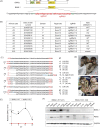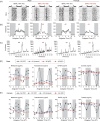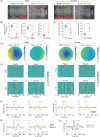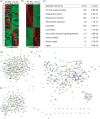BMAL1 knockout macaque monkeys display reduced sleep and psychiatric disorders
- PMID: 34691834
- PMCID: PMC8291534
- DOI: 10.1093/nsr/nwz002
BMAL1 knockout macaque monkeys display reduced sleep and psychiatric disorders
Abstract
Circadian disruption is a risk factor for metabolic, psychiatric and age-related disorders, and non-human primate models could help to develop therapeutic treatments. Here, we report the generation of BMAL1 knockout cynomolgus monkeys for circadian-related disorders by CRISPR/Cas9 editing of monkey embryos. These monkeys showed higher nocturnal locomotion and reduced sleep, which was further exacerbated by a constant light regimen. Physiological circadian disruption was reflected by the markedly dampened and arrhythmic blood hormonal levels. Furthermore, BMAL1-deficient monkeys exhibited anxiety and depression, consistent with their stably elevated blood cortisol, and defective sensory processing in auditory oddball tests found in schizophrenia patients. Ablation of BMAL1 up-regulated transcriptional programs toward inflammatory and stress responses, with transcription networks associated with human sleep deprivation, major depressive disorders, and aging. Thus, BMAL1 knockout monkeys are potentially useful for studying the physiological consequences of circadian disturbance, and for developing therapies for circadian and psychiatric disorders.
Keywords: BMAL1; aging; circadian rhythms; macaque monkey; psychosis; sleep disruption.
© The Author(s) 2019. Published by Oxford University Press on behalf of China Science Publishing & Media Ltd.
Figures





Similar articles
-
Cloning of a gene-edited macaque monkey by somatic cell nuclear transfer.Natl Sci Rev. 2019 Jan;6(1):101-108. doi: 10.1093/nsr/nwz003. Epub 2019 Jan 24. Natl Sci Rev. 2019. PMID: 34691835 Free PMC article.
-
High-frequency neural activity dysregulation is associated with sleep and psychiatric disorders in BMAL1-deficient animal models.iScience. 2024 Mar 1;27(4):109381. doi: 10.1016/j.isci.2024.109381. eCollection 2024 Apr 19. iScience. 2024. PMID: 38500822 Free PMC article.
-
Aging of intrinsic circadian rhythms and sleep in a diurnal nonhuman primate, Macaca mulatta.J Biol Rhythms. 2011 Apr;26(2):149-59. doi: 10.1177/0748730410395849. J Biol Rhythms. 2011. PMID: 21454295
-
Genomic perspectives on the circadian clock hypothesis of psychiatric disorders.Adv Genet. 2021;107:153-191. doi: 10.1016/bs.adgen.2020.11.005. Epub 2020 Dec 7. Adv Genet. 2021. PMID: 33641746 Review.
-
The functional significance of the skeletal muscle clock: lessons from Bmal1 knockout models.Skelet Muscle. 2016 Oct 13;6:33. doi: 10.1186/s13395-016-0107-5. eCollection 2016. Skelet Muscle. 2016. PMID: 27752300 Free PMC article. Review.
Cited by
-
The wrinkling of time: Aging, inflammation, oxidative stress, and the circadian clock in neurodegeneration.Neurobiol Dis. 2020 Jun;139:104832. doi: 10.1016/j.nbd.2020.104832. Epub 2020 Mar 13. Neurobiol Dis. 2020. PMID: 32179175 Free PMC article. Review.
-
An expedition in the jungle of pluripotent stem cells of non-human primates.Stem Cell Reports. 2023 Nov 14;18(11):2016-2037. doi: 10.1016/j.stemcr.2023.09.013. Epub 2023 Oct 19. Stem Cell Reports. 2023. PMID: 37863046 Free PMC article. Review.
-
Chicken cecal DNA methylome alteration in the response to Salmonella enterica serovar Enteritidis inoculation.BMC Genomics. 2020 Nov 23;21(1):814. doi: 10.1186/s12864-020-07174-w. BMC Genomics. 2020. PMID: 33225883 Free PMC article.
-
Suprachiasmatic nucleus dysfunction induces anxiety- and depression-like behaviors via activating the BDNF-TrkB pathway of the striatum.Transl Psychiatry. 2025 Mar 21;15(1):92. doi: 10.1038/s41398-025-03313-7. Transl Psychiatry. 2025. PMID: 40118822 Free PMC article.
-
Role of circadian clock in female embryo implantation.Front Cell Dev Biol. 2025 Jun 4;13:1607491. doi: 10.3389/fcell.2025.1607491. eCollection 2025. Front Cell Dev Biol. 2025. PMID: 40535570 Free PMC article. Review.
References
-
- Asher G, Sassone-Corsi P. Time for food: the intimate interplay between nutrition, metabolism, and the circadian clock. Cell 2015; 161: 84–92. - PubMed
LinkOut - more resources
Full Text Sources
